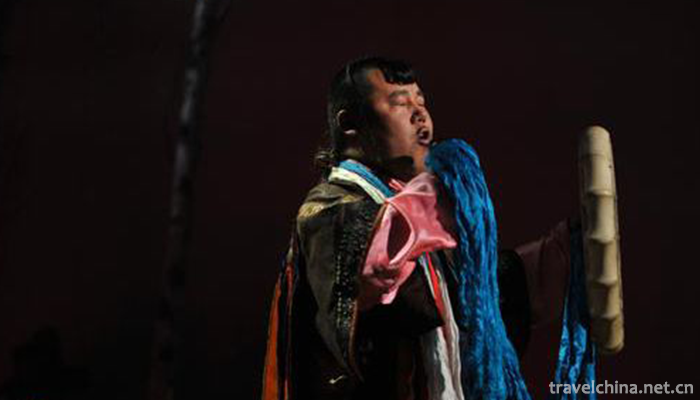Mongolian Humai
Mongolian Humai
Humai, also known as laryngeal singing, double singing, multi-voice singing or Haolinchao, is a singing method of many ethnic groups around Altai Mountains, not unique to the Mongolian people.
Humai is a magical singing art created by the indigenous peoples in Altai Mountains. It was spread over a vast area as early as the 12th century when Mongolia formed a nation: a singer sings two parts at the same time with his own vocal organ. The basic structure of Humai vocal part relationship is a combination of a continuous bass and the melody flowing above it. It can also be divided into "overtone humai", "tremor humai", "compound humai" and so on. It is unique among Chinese folk songs of all nationalities.
historical origin
According to textual research, the history of Humai can be traced back to the Hun Dynasty, that is, the Hun Dynasty had produced Humai. In hunting and nomadism, the ancestors of the Mongolian Plateau imitated the sound of nature piously. They believed that it was an important way to communicate with nature and the universe effectively and live in harmony. Thus, some potential of human voice organs were developed. One person could make "harmony" when imitating the sound of waterfalls, mountains, forests and animals, that is, the embryonic form of Humai.
About the emergence of Humai, the Mongols have a strange saying: Ancient people moved in the mountains, saw rivers diversion, waterfalls falling, mountains and valleys should be moving, heartfelt, heard dozens of miles, and then imitated, resulting in Humai. Among the Mongolians in the Altai Mountains of Xinjiang, Humai still exists today. Humai's repertoire is not particularly rich due to the limitation of special singing skills. Generally speaking, there are three types: one is singing beautiful natural scenery, such as "Taishan song", "river of cloth River" and so on. Two, it is the lovely image of wild animals, such as cuckoo and black bear, which retain the music remains of the mountain forest hunting pig culture period; three, praise the horses and grasslands, such as the four year old sea horse. In terms of its musical style, Humai is mainly short-key music, but it can also sing short long-key songs, which are not many. Judging from the legend of Humai and the theme of the repertoire, the singing form of "throat sound" is the product of the hunting culture of Mongolian mountain forests.
artistic characteristics
Humai singing method is produced under special regional conditions, production and lifestyle. Its voice production method and voice characteristics are rare. It is different from the world-famous Mongolian long tune singing method. Vocal music experts describe this singing method as "high as the top of the sky, low as the bottom of the sea, wide as the edge of the earth". Humai's vocal principle is special. Sometimes the vocal cords vibrate, sometimes they do not vibrate. It is the gas in the cavity that resonates. It uses special voice skills, one person sings two parts at the same time, forming a rare polyphonic form. The singer uses the technique of closing breath to make the breath impact the vocal cords violently and produce strong bubbles to form the bass part. On this basis, we can adjust the oral resonance skillfully, strengthen and concentrate overtone, and sing a clear and transparent high-pitched voice with metal sound, so as to achieve a wonderful sound effect.
As a special form of folk singing, Humai is an outstanding creation of the Mongolian people. It conveys Mongolian people's deep philosophical thinking and understanding of the natural universe and all things in the world, and expresses Mongolian people's pursuit of harmonious survival and development and healthy and upward aesthetic interest.
Inheritance significance
Humai is one of the oldest art forms of the Mongolian nation. It retains some elements of primitive singing more. It is a long-standing echo from the deep memory of the nation. It is closely related to the history and culture of the Mongolian people. It is of great value to anthropology, ethnology and folklore studies.
For this reason, the Humai art inherited and disseminated for the contemporary Mongolian nation not only stirred up the international music circle, but also aroused great interest and general concern of experts and scholars in sociology, anthropology, history, culture and art all over the world, and attracted more attention of national musicians and vocal experts and scholars. Mr. Lv Ji, the honorary chairman of the Chinese Musicians Association and a leading musician in the field of music theory, pointed out that "there is a kind of song in Mongolia that one sings two parts at the same time, which can not be imagined by outsiders, and we should study it carefully." Morgihu, honorary chairman of Inner Mongolia Sound Association, recently wrote: "Haolin Chaoer Music is the oldest music heritage with ancient cultural value, a living music fossil, and the most valuable music heritage of scientific exploration and understanding value among all ethnic and national music heritage discovered so far." In inheriting and developing the exquisite cultural heritage of the Mongolian people, the Inner Mongolian grassland lags far behind other Mongolian areas such as the foothills of the Altai Mountains, for example, Mongolia has already listed the art of Humai as a national treasure; the Russian Republic of Tuva regards it as a national soul; both countries have included the excavation and research of the art of Humai in the key disciplines of national art and introduced it into Mongolia. The ancient vocal music teaching system. The Central Conservatory of Music of China has also listed Humai Art as an important part of the national art subject, World Ethnic Folk Music. Professor Chen Ziming, Secretary of the Party Committee of the former Institute and expert of world Ethnomusicology, personally led the research.
Humai has been extinct in Inner Mongolia grassland for more than 100 years. It is also on the verge of being lost among Mongolian nationalities in Altai region of Xinjiang. Since the 1990s, people with lofty ideals in Inner Mongolia art circle have learned various singing skills of Humai from Mongolian Master Humai through various ways such as "Come in" and "Go out", and improved quickly. Among them, Sqinbilig, Zhang Zhaoxiang, Jiri Mutu, Baolidao and Baolida are outstanding. Since the 1990s, they have been active on the music stage at home and abroad (visiting Japan and Australia successively). Among them, Szyn Billiger has been hired to give lectures and perform demonstration performances in the Central Music Center. Their recordings and videos have been broadcasted many times in various forms of academic seminars at home and abroad. As early as the 1980s, the insightful scholars Morgihu and Da Buhe Chaolu began to study and introduce "Humai"; Inner Mongolia Song and Dance Troupe, Inner Mongolia Radio and Television Art Troupe and Mongolian Youth Chorus introduced different vocal music forms (such as folk art singing without accompaniment chorus) to the stage successively; only after the establishment of Oriental Film and Television Institute in 2000 did the art of Humai really come into being. Introduce the center of national art teaching.
It is an important and urgent task to rescue and protect the magical singing art of "Humai" from extinction.


-
1.Ancient Villages in Southern AnhuiXidi and Hongcun
Ancient villages in southern Anhui refer to some traditional villages distributed in Anhui and Jiangxi provinces of China and south of the Yangtze River.
Time 2018-12-08 -
2.The Simatai Great Wall
Simatai Great Wall is located in the north of Simatai Village, Gubeikou Town, northern Miyun District, Beijing. It is adjacent to Gubeishui Town. The wall of Simatai Great Wall is built on the steep m
Time 2018-12-10 -
3.Shanghai Fangta Garden
Fangta Garden is one of the gardens in the ancient city of Songjiang, which is mainly composed of historical relics. The garden covers an area of 182 mu. The site was originally the downtown center of
Time 2018-12-19 -
4.Bagong Mountain Tourist Scenic Area
Since 2001, Bagongshan Scenic Area has listed Bagongshan National Geopark, Bagongshan National Forest Park and Bagongshan National AAAA Tourist Area successively. Bagong Mountain is a famous historica
Time 2018-12-23 -
5.Zhaohua Ancient City Scenic Area
The ancient city of Zhaohua has a long history and rich humanities in Zhaohua Town, Zhaohua District, Guangyuan City, Sichuan Province. The original name of Yichang County was changed to Zhaohua Count
Time 2019-03-17 -
6.Eight polar boxing
Bajiquan is a kind of boxing in Chinese Wushu. The word "eight poles" of this boxing method originated from the concept of Palaeogeography and originated from the Han Dynasty
Time 2019-04-02 -
7.Daur traditional Hockey
Daur's traditional hockey sport is called "Bei Kuo Taj Ke Bei" in Daur language. Bei Kuo refers to a bat. The Daur bat is made by grinding oak wood with curved roots and straight branches. I
Time 2019-04-22 -
8.Diabolo
Diabolo is a splendid flower in Chinese traditional culture garden. Diabolo used to be called "Hu Dao", also known as "ground bell", "empty bell", "wind gourd".
Time 2019-04-28 -
9.Guilin fishing drum
Guilin fishing drum, commonly known as sentiment, is the local traditional rap and singing art of Guilin. The Song Dynasty was introduced into Guilin from the north,
Time 2019-05-02 -
10.Thousand Buddha Cliffside Sculptures
Qianfo cliff, located 4 kilometers north of Guangyuan City, on the East Bank of Jialing River and on the ancient Shu Road of Jinniu, has a long history and exquisite carving skills. The grottoes began in the late Northern Wei Dynasty, flourished in the Tang Dynasty and ended in the Qing Dynasty. After thousands of years
Time 2020-11-08 -
11.Meishan scenic spot
Meishan has a long history and culture and many cultural relics. Meishan County, where the municipal government is located, has a history of 1505 years. It is a famous town of Sansu culture. There are 2 provincial cultural relics protection unit
Time 2020-12-18 -
12.Dazhou landform
The terrain of Dazhou city is high in the Northeast (Daba Mountain Area) and low in the Southwest (Basin hilly area). The highest point is datuanbao, Jichang Township, Xuanhan County, with an altitude of 2458.3 meters; the lowest is Tianguan village, Wan
Time 2020-12-20